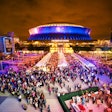
Event venues have been pulling out all the stops to keep attendees safe at live events and meetings in recent months. And while some measures—like capacity restrictions, mandatory masks, temperature checks and vaccination-only sections—may be temporary, there are other, more permanent solutions that we sure hope stick around. Because even when COVID-19 is in the rearview mirror, attendee health and safety will undoubtedly be a huge area of focus for the foreseeable future.
1. On-site telemedicine stations
While large events like trade shows and festivals have long featured on-site doctors and medical areas, some venues are now leaning into cutting-edge technology to offer even more health services for attendees. For example: The Las Vegas Convention Center, which just completed a long-anticipated $1 billion expansion, is now offering a high-tech virtual health care station operated by Florida-based company OnMed. The station made its debut at Informa’s World of Concrete trade show earlier this month; it’s a self-contained medical unit that uses technology like video chats and thermal imaging to directly connect patients with health care professionals who can conduct medical exams, dispense prescription medications and more. As an added safety measure, the station is thoroughly cleaned with high-output ultraviolet surface and ionized air sanitization after every patient visit.
“This is the type of location that we had in mind when we were developing the stations,” explains OnMed CEO Austin White. “It’s an environment where there are large groups of people who can’t access their regular doctor or clinic, but accessing convenient, trusted and secure health care is essential.” The Las Vegas Convention Center’s OnMed telemedicine station can serve two patients at once; it’s open from 7 a.m. to 5 p.m. on convention days. Privacy glass and directional speakers safeguard patient confidentiality, and all record storage is HIPAA compliant.Photo: Courtesy of the Las Vegas Convention Center
The Las Vegas Convention Center’s OnMed telemedicine station can serve two patients at once; it’s open from 7 a.m. to 5 p.m. on convention days. Privacy glass and directional speakers safeguard patient confidentiality, and all record storage is HIPAA compliant.Photo: Courtesy of the Las Vegas Convention Center
2. Health-focused event partnerships
Visit Anaheim, the Southern California city’s CVB, has teamed up with local healthcare network Hoag to provide clinical solutions for events, meetings and conventions in the wake of COVID-19. In addition to offering on-site testing and health screenings, on-call clinic support and more, clients with a scheduled event are eligible for a complimentary pre-event review of their health and safety plan, with comments and recommendations provided by Hoag within one week. (If local health guidelines change before an event, clients can resubmit their plans for a second review.)
“Through this partnership, planners will receive the assurance they need that their event is not only meeting local requirements but that attendees are being provided an optimal environment for their health and safety,” says Jay Burress, president and CEO of Visit Anaheim, who sees this partnership continuing long after COVID-19 has faded. “The pandemic has inspired our organization to reinvent how we do business and reevaluate the services we offer our clients, whether that’s creating hybrid options or presenting clinical solutions. We know health and safety are always going to be a top priority for any event, so this service through Hoag will certainly always be a worthwhile option to offer our clients.” Visit Anaheim’s partnership with Hoag will provide safety consultations for the CVB’s meeting planner clients, who are booking events at local venues like the 1.8 million-square-foot Anaheim Convention Center.Photo: Courtesy of Anaheim Convention Center
Visit Anaheim’s partnership with Hoag will provide safety consultations for the CVB’s meeting planner clients, who are booking events at local venues like the 1.8 million-square-foot Anaheim Convention Center.Photo: Courtesy of Anaheim Convention Center
3. Enhanced air filtration systems
One major health consideration that has emerged during the pandemic is the importance of quality air filtration, largely considered to be the most effective way to combat COVID-19. Existing and new-build hotels, convention centers and other venues have been investing in advanced systems; the Hotel Paso del Norte in El Paso, Texas, for example, reopened in Aug. 2020 as one of the first properties to institute the Plasma Air system, which is installed in the hotel’s HVAC system and has been shown to kill 99% of bacteriophage in the air after 10 minutes of use.
Another venue adopting the idea is the Albany Capital Center in New York, where the operation team, ASM, is working to take air purification even further than the state’s recommendations. By September 2021, the facility plans to deploy needlepoint bipolar ionization technology, which will actively and continuously purify indoor air quality to reduce airborne and surface contaminants, pollutants and viruses such as COVID-19.
Duncan Stewart, executive director of the Albany Convention Center Authority, says the tech was chosen after an extensive testing process that showed it would “provide the highest rate of air cleansing while being environmentally safe, as the type selected produces no measurable ozone." He continues, "Indoor air quality has and will always be a focus of this team, and as this technology has the capacity to remove pathogens and particulates of any type, its utility is for the long term.” At the 159,000-square-foot Albany Capital Center, the goal is to "assure the best possible attendee experience and working environment for staff and vendors—not only in response to the COVID-19 pandemic but as responsible stewards of this important public facility," says executive director Duncan Stewart.Photo: Courtesy of Albany Capital Center
At the 159,000-square-foot Albany Capital Center, the goal is to "assure the best possible attendee experience and working environment for staff and vendors—not only in response to the COVID-19 pandemic but as responsible stewards of this important public facility," says executive director Duncan Stewart.Photo: Courtesy of Albany Capital Center
4. Safety measures verified by outside experts
It’s one thing for an event venue to tell you how they’re being safe. It’s quite another for them to prove it by achieving an advanced certification. The Las Vegas Convention Center, Anaheim Convention Center and Albany Capital Center—not to mention hundreds of other event venues around the country—have all achieved the GBAC STAR accreditation. The program, created by the Global Biorisk Advisory Council (a division of ISSA, the worldwide cleaning industry association), provides venue-cleaning professionals with best practices on how to prepare and respond to infectious diseases and biohazards.
That’s not the only safety-focused accreditation that venues have been striving for post-pandemic. In June 2020, the International WELL Building Institute (IWBI)—a global organization that's focused on ways buildings of all types can enhance health and wellness—introduced its WELL Health-Safety Rating for Facility and Management; New York’s Yankee Stadium quickly became the first sports and entertainment venue in the world to achieve the rating. The hotel industry, meanwhile, has been focused on digital health company Sharecare and Forbes Travel Guide’s VERIFIED health security badge, which has venue operators undergo a multistep process surrounding building preparation, the fan journey, sanitization, air circulation and more. (In April, Los Angeles announced plans to become the first Sharecare VERIFIED destination in the U.S. by verifying the health security of all hotels with 50 or more rooms in the city.)
5. Creative uses of technology
Disinfecting drones, contactless robots, thermal imaging cameras… oh, my! Venues are leaning on technology more than ever to bring back live events—and many of those measures are unlikely to vanish anytime soon. In addition to providing effective cleaning services, tools that allow for contactless hotel check-in, event registration and payment methods have cut down on lines and ensure a more seamless—and sanitary—experience. New technology can also facilitate crowd control; the TCF Center in Detroit, for example, is tracking Wi-Fi usage in the facility to understand crowd density—something that can certainly come in handy long-term for security purposes, too. “The reports allow show managers to make quick adjustments in crowd control to assure guest safety,” explains the venue’s website.
Related: 15 Tech Tools That Can Help Bring Back Live Events Relay, a service robot from Savioke, has seen increased demand by hotels during the pandemic. The bots can facilitate contactless deliveries of everything from food and beverage to linens to event materials, and even handle check-in/check-out services. The robot can also operate elevators and navigate crowds. Each hotel chooses its own name for the robot and has the ability to wrap it to their liking.Photo: Courtesy of Savioke
Relay, a service robot from Savioke, has seen increased demand by hotels during the pandemic. The bots can facilitate contactless deliveries of everything from food and beverage to linens to event materials, and even handle check-in/check-out services. The robot can also operate elevators and navigate crowds. Each hotel chooses its own name for the robot and has the ability to wrap it to their liking.Photo: Courtesy of Savioke
6. Line-queuing solutions
Going hand-in-hand with seamless registration procedures and technology are new line-queuing solutions that can cut down on the time event attendees and consumers are spent waiting to enter an experience. A good option comes from tech company Waitwhile, which offers a cloud-based line-management platform called Spot Holder that’s currently being used for events at Fashion Show Las Vegas and other venues. How it works: Guests join a virtual waitlist by providing their name and phone number, and then are able to track their place in line remotely. When it’s time to return to the venue, Spot Holder sends a notification to the phone number provided. A bonus? The tech has a capacity-management feature that keeps a tally of people entering and exiting, so you can be sure not to surpass capacity restrictions.
7. Virtual-forward solutions like hybrid studios and digital site visits
As hybrid events grow in popularity, an increasing number of convention centers, hotels and other event venues are implementing creative, tech-forward solutions to accommodate both a virtual and in-person audience. (Click here for our recent roundup of 15 such venues around the country, all of which have installed permanent studios geared towards livestreaming and filming.)
There’s also been a clear focus on virtual site visits too. While no means new during the pandemic, venues took the time to enhance their offerings—meaning planners around the world can get a more clear view of available spaces without booking a flight. A recent advancement comes from Concept3D, which has debuted 360° Map. Currently in use at the Hawaii Convention Center, the Indianapolis Motor Speedway and others, the 3D navigation tool allows users to spin, tilt and rotate around accurate 3D models; now the structures, grounds and even the trees on the new map can be viewed from north, south, east and west, providing a realistic experience with greater precision.  Up next, Concept3D is working with the Hawaii Convention Center (pictured) to implement this functionality to the interiors, which will be an ideal tool for planners in selecting rooms, planning layouts and more.Photo: Concept3D
Up next, Concept3D is working with the Hawaii Convention Center (pictured) to implement this functionality to the interiors, which will be an ideal tool for planners in selecting rooms, planning layouts and more.Photo: Concept3D



















